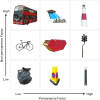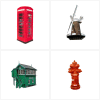Retrosplenial cortex codes for permanent landmarks
- PMID: 22912894
- PMCID: PMC3422332
- DOI: 10.1371/journal.pone.0043620
Retrosplenial cortex codes for permanent landmarks
Abstract
Landmarks are critical components of our internal representation of the environment, yet their specific properties are rarely studied, and little is known about how they are processed in the brain. Here we characterised a large set of landmarks along a range of features that included size, visual salience, navigational utility, and permanence. When human participants viewed images of these single landmarks during functional magnetic resonance imaging (fMRI), parahippocampal cortex (PHC) and retrosplenial cortex (RSC) were both engaged by landmark features, but in different ways. PHC responded to a range of landmark attributes, while RSC was engaged by only the most permanent landmarks. Furthermore, when participants were divided into good and poor navigators, the latter were significantly less reliable at identifying the most permanent landmarks, and had reduced responses in RSC and anterodorsal thalamus when viewing such landmarks. The RSC has been widely implicated in navigation but its precise role remains uncertain. Our findings suggest that a primary function of the RSC may be to process the most stable features in an environment, and this could be a prerequisite for successful navigation.
Conflict of interest statement
Figures






References
-
- Tolman EC (1948) Cognitive maps in rats and men. Psychol Rev 55: 189–208. - PubMed
-
- Lynch K (1960) The Image of the City. Cambridge, Mass.: Technology Press.
-
- Golledge RG (1991) Cognition of physical and built environments. In: Garling TE, Gary W, editors. Environment Cognition and Action an Integrated Approach. Oxford University Press. 35–62.
-
- Siegel A, White S (1975) The development of spatial representations of large-scale environments. In: Reese HW, editor. Advances in Child Development and Behaviour. Academic Press. 9–55. - PubMed
-
- Downs RM, Stea D (1977) Maps in Minds: Reflections on Cognitive Mapping. Harper & Row.
Publication types
MeSH terms
Grants and funding
LinkOut - more resources
Full Text Sources

